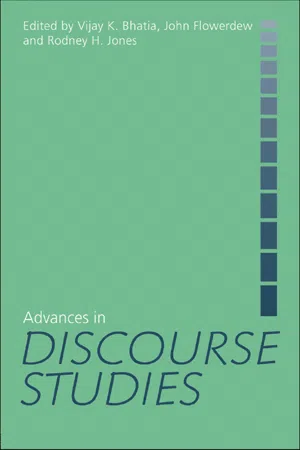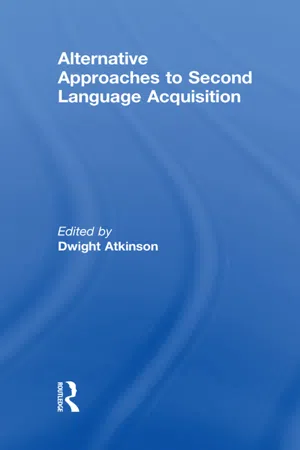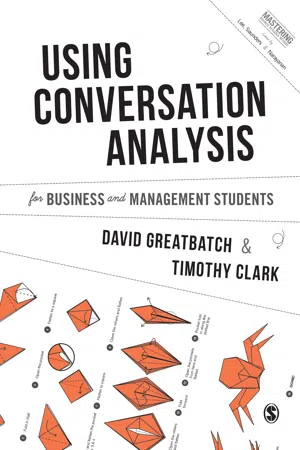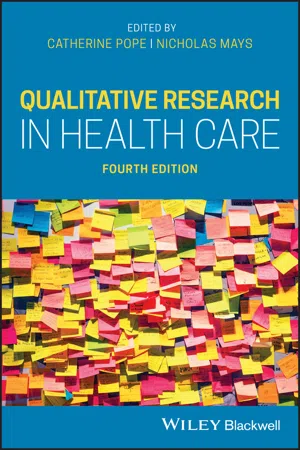Conversation Analysis
Conversation Analysis is a research method used to study the structure and organization of human interaction through the analysis of recorded conversations. It focuses on the detailed examination of how people use language in social interactions, including turn-taking, repair, and sequence organization. This approach provides insights into the underlying rules and patterns that govern communication in everyday life.
8 Key excerpts on "Conversation Analysis"
- eBook - ePub
- John Flowerdew(Author)
- 2012(Publication Date)
- Routledge(Publisher)
...CHAPTER 7 Conversation Analysis 7.1 INTRODUCTION In this chapter, we will consider the approach to spoken interaction known as Conversation Analysis (CA). There are strong reasons for focusing on conversation in Discourse Analysis, because, as noted by Levinson (1983: 284), ‘conversation is clearly the prototypical kind of language usage, the form in which we are all first exposed to language — the matrix for language acquisition.’ 1 CA was developed within the context of sociological enquiry and was pioneered by a breakaway group of American sociologists, sometimes also referred to as ethnomethodologists, under the leadership of Harold Garfinkel and followers such as Harvey Sacks, Emanuel Schegloff and Gail Jefferson. Given their sociological background, these researchers were interested in studying how language was employed in social interaction rather than developing linguistic theory. Instead of applying some overarching theory concerning social structure, however, they worked inductively with empirical data in the form of recordings of naturally occurring talk, which was transcribed in a detailed fashion. The aim was, and remains to this day in ongoing work, to describe social interaction in terms of the actions it is used to perform, not from the outside, but from the inside, from the perspective of the user (referred to as an emic perspective). According to CA, conversation is conceived of as speech actions which build together to create coherent social interaction. CA does not apply any model of speech acts such as those reviewed in Chapter 4 (indeed, it does not use the term speech act). Rather, true to their ethnomethodological approach, conversation analysts use, as far as possible, categories employed by the participants involved in interaction themselves...
- eBook - ePub
- Vijay Bhatia, John Flowerdew, Rodney H. Jones(Authors)
- 2008(Publication Date)
- Routledge(Publisher)
...(2001) Responding in Conversation: a study of response particles in Finnish, Amsterdam: John Benjamins. Tanaka, H. (1999) Turn-taking in Japanese Conversation: a study in grammar and interaction, Amsterdam: John Benjamins. Tannen, D. (1989) Talking Voices, Cambridge: Cambridge University Press. ten Have, P. (1999) Doing Conversation Analysis: a practical guide, Thousand Oaks, CA: Sage. Wooffitt, R. (2005) Conversation Analysis and Discourse Analysis : a comparative and critical introduction, London: Sage. 2 Conversation Analysis Overview and new directions Paul Drew and Traci Curl The background and programme of Conversation Analysis Conversation Analysis (CA) is founded on a sociological conceptualization of the basically social nature of language use in human interaction. However as the work in CA has developed, it has come to be a truly multi-disciplinary field; and in this account of recent developments and the directions in which we see CA heading, we will highlight particularly the implications which CA’s methods and findings are having for core areas in linguistics – focusing especially on the syntax of social actions in talk. But to begin with, we will briefly review the background to CA’s programme. CA is a field of study concerned with the norms, practices and competences underlying the organization of social interaction. Notwithstanding its name, it is concerned with all forms of spoken interaction including not only everyday conversations between friends and acquaintances, but also interactions in medical, educational, mass media and socio-legal contexts, relatively ‘monologic’ interactions such as lecturing or speech-making, and technologically complex interactions such as web-based multiparty communication...
- Dwight Atkinson, Dwight Atkinson(Authors)
- 2011(Publication Date)
- Routledge(Publisher)
...In talk, practices such as turn-taking, turn - construction, and repair are fundamental. Through them speakers organize the intersubjective meaning of any activity or practice. Since the 1960s, CA has described a large variety of specific, orderly practices in talk. Conversation-analytic studies deliver systematic, robust descriptions of social practices. A set of methodological and analytic principles follows. Data Quality Conversation Analysis is data-driven. Data are collected in environments where participants are involved in consequential everyday activities—e.g., family life, work, or education. CA refers to these data as naturally occurring ; that is, they are not produced for the analyst. Thus, to study doctor–patient communication, one needs to collect data from real doctor–patient interactions rather than actors and students role-playing these roles. CA does not study language as an abstract system, nor does it assume that studying the social organization of one setting (e.g., research interviews), licenses inferences to a differently organized setting (such as social scenes talked about in the interview). Data relevant for CA are everywhere, since everyday life is everywhere. This is because, for CA, conversation is the primordial site of sociality, it is through activities managed in conversation that we conduct our ordinary social affairs, and the practices to be found in the highly organized structures and patterns in conversation underlie our ability to communicate meaningfully with one another—hence they are fundamental communicative competencies. (Drew, 2005, p. 76) Data are transcribed at a level of granularity that makes visible the details of the sequential and temporal organization of the talk...
- David Greatbatch, Timothy Clark(Authors)
- 2017(Publication Date)
- SAGE Publications Ltd(Publisher)
...3 Basic Components Of Conversation Analysis In this chapter we examine CA methodology in more detail. We will consider why CA researchers insist on the use of audio and video recordings to study talk in interaction and discuss how they approach the tasks of analysing and transcribing these data. The chapter is structured under the following headings: Using recording technologies Formulating research questions Transcribing recordings Focus of analysis Modes of analysis Constraints on analysis Analysing talk in institutional settings. Using Recording Technologies CA researchers argue that, for the analysis of social interaction, audio and video recordings of naturally occurring social interaction offer several important advantages over alternative sources of data, such as responses to questionnaires, interview data, observational studies relying on field notes or coding procedures, idealized or invented examples based on the researcher’s own native intuitions, and experimental methodologies...
- eBook - ePub
Researching Discourse
A Student Guide
- Christopher Hart, Christopher Hart(Authors)
- 2020(Publication Date)
- Routledge(Publisher)
...But its analyses have proved useful in a range of approaches to discourse, including Interactional sociolinguistics, critical discourse analysis, and multimodal discourse analysis. It has provided insights into a range of social interactions. As often happens, academic boundaries that were once fought over fiercely are now open to some negotiations and trade back and forth. Further reading Two widely-used textbooks of Conversation Analysis are Hutchby and Wooffitt (1998) and Ten Have (2007). A broader intellectual background for ethnomethodology and CA can be found in Heritage (1984) and Silverman (1998). If you take up CA as a central part of what you are doing, it is worth reading some of Sacks’ lectures (Sacks, 1992); they are wider ranging and more accessible than the publications he completed in his short lifetime, and they give a wonderful sense of a mind at work (they have a very detailed index, so you can pick out some lectures relevant to what you are doing). One journal that consistently publishes quite specialised CA is Research on Language and Social Interaction ; applications are often found in such journals as Language in Society and the Journal of Pragmatics. References Antaki, C. (2002). An introductory tutorial in Conversation Analysis. Retrieved 15/2/2018, from http://ca-tutorials.lboro.ac.uk/sitemenu.htm%3E. Atkinson, J.M. and Heritage, J. (Eds.) (1984). Structures of social action: Studies in Conversation Analysis. Cambridge: Cambridge University Press. Benwell, B. (2012). Common-sense anti-racism in book group talk: The role of reported speech. Discourse & Society, 23 (4), 359–376. Boden, D. (1994). The business of talk: Organizations in action. Cambridge: Polity Press. Clayman, S. and Heritage, J. (2002). The news interview: Journalists and public figures on air. Cambridge: Cambridge University Press. Du Bois, J.W., Chafe, W.L., Meyer, C., Thompson, S.A., Englebretson, R., and Martey, N...
- eBook - ePub
- Catherine Pope, Nicholas Mays, Catherine Pope, Nicholas Mays(Authors)
- 2019(Publication Date)
- Wiley-Blackwell(Publisher)
...10 Conversation Analysis Geraldine M. Leydon 1 and Rebecca K. Barnes 2 1 Faculty of Medicine, University of Southampton, Southampton, UK 2 Centre for Academic Primary Care, University of Bristol, Bristol, UK 10.1 Introduction This chapter provides a brief introduction to Conversation Analysis (CA) and its application in health care research. CA can be thought of usefully as both theory and method. From this chapter, readers will gain an overview of key theoretical principles, the sorts of research questions CA can address, how to collect and analyse CA data, and how to disseminate findings, but we encourage further reading and specialised training for those planning to undertake this type of analysis. We illustrate the different kinds of data conversation analysts can work with, showing the level of transcription that is needed to facilitate analysis, what analysis looks like, and direct practical applications to help readers understand what the method involves and the valuable role it can play. 10.2 What Is CA? The foundations of CA lie in North America with the work of three sociologists: Harvey Sacks, Emanuel Schegloff, and Gail Jefferson. Sacks described CA as an ‘observational science’ concerned with the analysis of everyday talk to make explicit what ‘we’ (as members of society) know practically. For example, in 1964, Sacks had been pondering a recurrent challenge that was reported by call takers at the Suicide Prevention Centre in Los Angeles; namely, how to solicit callers' names. Sacks was given access to stenographic transcripts and tapes of telephone calls to the Centre. He observed a repeated pattern that when a caller did not give her name during the opening exchange, it was likely to be difficult for the call taker to elicit it later in the call. With his colleague, Schegloff, Sacks' approach to working with recordings of real‐life data was the springboard for a new programme of sociological work focusing on ‘ordinary conversation’...
- eBook - ePub
- Anthony J. Liddicoat(Author)
- 2021(Publication Date)
- Bloomsbury Academic(Publisher)
...Conversation analytic research therefore has the potential to contribute to language pedagogy and assessment an d not just to the development of more nuanced studies of language acquisition. Some experimentation on pedagogy using Conversation Analysis has begun (e.g. Barraja-Rohan, 2011 ; Wagner, 2015), but there is a need for much more development in this field. Conversation Analysis across languages and cultures Although there has been some interest in comparing how interactions happen in different cultural and linguistic contexts (e.g. Moerman, 1988), Conversation Analysis has been reluctant to take on cross-cultural or cross-linguistic comparisons largely because of the difficulty involved in comparing highly contextualized moments of interaction across contexts. Comparisons between languages and cultural contexts can shed light on how human beings deal with the same issues and problems of human interaction using the linguistic and cultural resources that they have available to them. Comparative studies of interaction are able to show that interactional practices involve both aspects that are universal and others that vary. For example, Rossano, Brown and Levinson (2009) compared how gaze is coordinated with talk in question-answer sequences, in two-speaker interactions among acquainted participants speaking Italian, Yélî Dnye and Tzeltal, and revealed that the gaze of speakers producing questions is more consistent across the three cultural groups than the gaze of the question recipient. The study therefore shows that a prevailing view that gaze is a cross-culturally valid indicator of recipiency may not be correct as recipients use gaze differently across the three languages. The study also shows that Tzeltal speakers, who do not use gaze consistently as a marker of recipiency, are more likely to use repetition to show recipiency...
- eBook - ePub
- Michele Knobel, Judy Kalman, Colin Lankshear, Michele Knobel, Judy Kalman, Colin Lankshear(Authors)
- 2020(Publication Date)
- Myers Education Press(Publisher)
...This is in contrast to approaches that depend on abstract theories, statistical analysis, controlled experiments, or imagined scenarios, all of which are seen to obscure how order is produced. Approaches such as interviews are also inadequate because, although people follow rules of interaction, they cannot always fully and accurately account for them afterward. Conversation Analysis aims to analyze some phenomenon as it happens in real time. One of the seminal studies in Conversation Analysis, and a must-read for anyone interested in this approach, is Sacks, Schegloff, and Jefferson’s (1974) “A Simplest Systematics for the Organization of Turn-Taking for Conversation,” in which they outline the basic organizing principles of everyday conversation, such as what constitutes a turn in conversation and how a turn is passed from one speaker to the next. In lieu of summarizing their findings, here are key implications I consider most important for our discussion. First, everyday conversation is the most basic form of social interaction; all other kinds of interactions differ in what rules of basic conversations are constrained or suspended. For example, although turns and topics are not predetermined in everyday conversation, they often are in institutional settings, such as courtrooms or debates. Institutional talk is also sometimes managed by an authorized figure, such as a teacher or a judge, instead of locally managed among speakers. Second, conversations are self-correcting systems. If a “glitch” occurs, it self-adjusts through the collaborative effort of all participants involved. A common occurrence is when two people speak at once. In everyday conversation, the turn will be renegotiated so that only one person assumes the right to speak...







